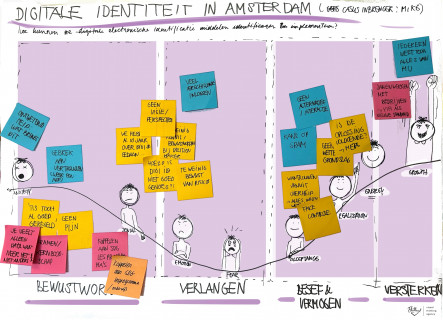The Digital Government Act (Wet Digitale Overheid) aims to improve digital government services while ensuring citizens' privacy. An important part of this law is safe and secure logging in to the government using new electronic identification methods (eIDs) such as Yivi (formerly IRMA). The municipality of Amsterdam recently started a pilot with Yivi. Amsterdam residents can now log in to “Mijn Amsterdam” to track the status of complaints about public area’s. But how do you get this innovation, which really requires a different way of thinking, implemented?
Using the Change Curve to categorise barriers
At the Transition day (June 2023), Mike Alders (municipality of Amsterdam) invited the Amsterdam Smart City network to help identify the barriers and possible interventions, and explore opportunities for regional cooperation. Led by Coen Smit from Royal HaskoningDHV, the participants identified barriers in implementing this new technology from an organisational and civil society perspective. After that, the participants placed these barriers on a Change Curve, a powerful model used to understand the stages of personal transition and organization stage. Using the Change Curve, we wanted to give Mike some concrete guidance on where to focus his interventions on within the organisation. The barriers were categorised in four phases:
- Awareness: associated with anxiety and denial;
- Desire: associated with emotion and fear;
- Knowledge & ability: associated with acceptance, realisation and energy;
- Reinforcement: associated with growth.
Insights and next steps
In the case of digital identity and the implementation of eID’s, such as Yivi, it appears that most of the barriers are related to the first phase of awareness. Think of: little knowledge about digital identity and current privacy risks, and a lack of trust in a new technology. Communication is crucial to overcome barriers in the awareness. To the user, but also internally to employees and the management. Directors often also know too little about the topic of digital identity.
By looking at the different phases in the change process, we have become aware of the obstacles and thought about possible solutions. But we are still a long way from full implementation and acceptance of this new innovation. For that, we need different perspectives from business, governments and knowledge institutions. This way, we can start creating more awareness about digital transformations and identity in general, which will most likely lead to wishes for more privacy-friendly and easier way of identifying online. Besides focusing on creating more awareness about our digital identity, another possible next step is to organise a more in-depth session (deepdive) with all governmental organisations in the Amsterdam Smart City network.
Do you have any tips or questions in relation to Mike’s project about Digital Identity and electronic Identification? Please get in touch with me through sophie@amsterdamsmartcity.com or leave a comment below.






Interesting topic! Are you focusing on identities of persons or also considering identities of organizations (e.g. persons representing an organization)? The Digital Government Act (Wet Digitale Overheid) covers both and Yivi also support both.